
Whether you are a seasoned chef or a home cook who likes to expand your cooking skills, you may ask yourself what truffles taste like.
What Does Truffle Taste Like
A distinct aroma. An earthy flavour. A combination of garlic, mushrooms, and even a touch of musk. Chefs describe the taste of truffles as an exploration of the senses that will leave a lasting impression.
Chefs compare the intoxicating scent of truffles to the forest floor after a rain or the deep, alluring fragrance of a very fine perfume. Aroma is the truffle’s first impression and sets the stage for the culinary experience that follows.
The truffle experts at Truffle Hill tout these delectable fungi as a way to add a delicious punch of flavour to any dish.
Truffles with imperfections are cut up and used as an ingredient to enhance the flavour of various dishes in different cuisines. Some chefs will even shave off a truffle onto a dish at the table side for their customers.
Most chefs use truffles in the back of the house to add a delicious flavour and aroma to dishes before they reach the customer.
What Chefs Are Saying
Truffles are considered a culinary delicacy, and they have captured the hearts and palates of chefs and food enthusiasts worldwide for centuries.
These mysterious fungi, often called “diamonds of the kitchen,” boast a unique, complex flavour profile that chefs praise and celebrate.
Chef Gordon Ramsay describes truffles as the black gold of the culinary world. Since they are so versatile, truffles can enhance and complement a wide range of ingredients, from creamy sauces to grilled meats.
What’s their secret?
Umami.
Often referred to as the fifth taste, umami is a savoury and mouthwatering quality that enhances the overall flavour of a dish. Truffles can infuse dishes with an umami-rich depth unmatched by any other ingredient.
Truffles are the ultimate “umami bombs,” capable of transforming a simple pasta dish or risotto into a gourmet masterpiece.

Varieties of Truffles
Truffles come in an array of varieties, with the two most sought-after being the black truffle (Tuber melanosporum) and the white truffle (Tuber magnatum). Each boasts a unique flavour profile, and some chefs prefer one over the other.
Black truffles are commonly used in cooking and are known for their strong, earthy aroma and robust flavour. Chefs describe black truffles as having notes of garlic, forest floor, and even a hint of chocolate. They are often used in dishes, such as pasta, risotto, and sauces, to add more depth to them.
On the other hand, white truffles are considered even more luxurious and are typically shaved thinly over dishes just before serving to preserve the delicate aroma and flavour.
White truffles have an intoxicating scent described as a mixture of garlic, shallots, and a touch of honey, bringing a touch of magic to every plate they grace.
The Allure of Truffles
Truffles signify luxury and indulgence, so chefs are not shy about admiring this prized ingredient.
Thomas Keller, a chef known for his Michelin-starred restaurants, equated truffles with a chef’s dream since they can elevate a dish to unparalleled decadence.
The seasonal nature of truffles and their rarity adds to the allure, making them a coveted ingredient in top-quality cuisine. Chefs get excited when truffle season comes as they prepare to use these unique and delicious fungi in their many creations.
Some chefs create an array of different amazing dishes that have become synonymous with great culinary excellence — all featuring truffles, of course.
The delicate touch required to handle these precious fungi adds to the artistry of cooking with truffles, which many chefs view as culinary craftsmanship requiring precision and finesse.
Truffles create unforgettable dining experiences. Chefs relish the reactions of diners who savour a truffle-infused dish for the first time. The delight and satisfaction on a customer’s face when they taste the unique flavour of truffles, is a source of pride for many chefs.
Truffle Hill
Chefs and critics alike say that the finest black truffles in the world come from Truffle Hill and the Southwestern Australia area.
Truffle Hill, nestled in the Manjimup area of Western Australia, boasts a large farm that produces all types of truffles. We also offer truffle-infused products, such as honey, oil, salt, and even hot sauce.
Whether you are a chef looking for the best truffles in the world to use in your exquisite cuisine or you simply want to know what truffles taste like, visit the Truffle Hill website to order your truffles today!



